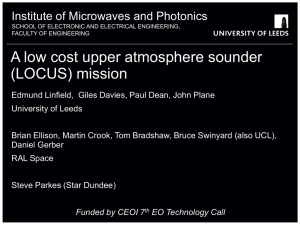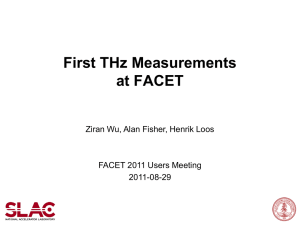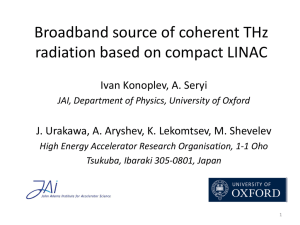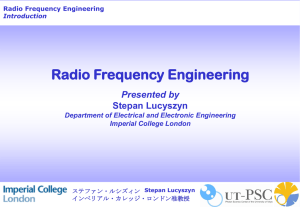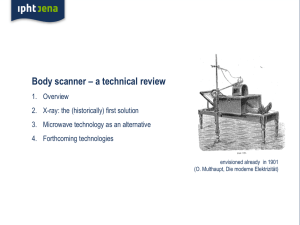Intense Terahertz Generation and Spectroscopy of Warm Dense
advertisement
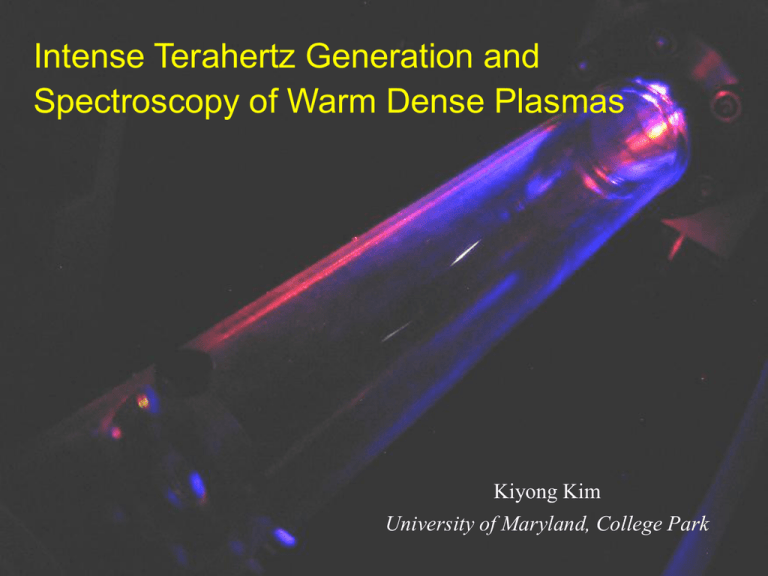
Intense Terahertz Generation and Spectroscopy of Warm Dense Plasmas Kiyong Kim University of Maryland, College Park Collaborators: Kishore Yellampalle George Rodriguez Toni Taylor Jim Glownia LOS ALAMOS NATIONAL LABORATORY Outline: • Background: - Terahertz (TH) science. • Intense THz generation: - Two-color photoionization. • THz spectroscopy: - Warm dense plasmas. Phenomena at terahertz (THz) frequencies: 1 THz = 1012 Hz =1 ps = 300 m = 0.004 eV = 33.3 cm-1 molecules Rydberg atoms Gaseous and solid-state plasmas Semiconductor nanostructures Figure courtesy of Klaas Wynne Biomolecules & proteins Strong THz sources: Large facility THz sources* FEL Linacs Photo courtesy: DESY Stanford, UCSB, FELIX Free electron lasing SLAC, JLab,BNL synchrotron radiation Synchrotrons Photo courtesy: ALS ALS (BNL) Coherent synchrotron radiation * M. S. Sherwin et al., DOE-NSF-NIH Workshop on Opportunities in THz Science Intense THz generation: Two-color photoionization Two-color photoionization: Four-wave mixing * THz = + - 2 2 plasma Lens SHG But the third order nonlinearity originating from bound electrons of ions ((3)ions) and free electrons ((3)free-electrons) via ponderomotive or thermal effects is too small to explain the measurements. (3)plasma = (3)ions + (3)free-electrons THz pulse * M. Kress et al, Opt. Lett. 29, 1120 (2004); T. Bartel et al, Opt. Lett. 30, 2805 (2005); X. Xie et al, Phys. Rev. Lett. 96, 075005 (2006). THz generation mechanism: e- e- THz eDirectional quasiDC current e- e- e- e- e- 2 BBO crystal Current surge THz generation THz energy measurement: 1000 THz energy vs laser energy Kr 800 Ar 600 N2 Air 400 200 He 0 0 200 400 600 Pressure (torr) S i filte r 800 P yro e le ctric sig n a l (m V ) Pyroelectric signal (a.u.) THz energy vs pressure 600 400 S i + P .E . filte r 200 S i + T e flo n filte r 0 0 5 10 15 20 L a se r e n e rg y (m J) • ETHz ~ 5 J/pulse with Kr (C.E. > 10-4) K. Y. Kim et al., Nature Photonics doi:2008.153 (2008). THz spectrum measurement: 1 .0 (a) Fourier-transform spectra A r 1 0 to rr S p e c tra l p o w e r (n o rm .) P yroelectric signal (norm .) Field autocorrelations 0 .5 (b) A r 1 0 0 to rr S p e c tra l p o w e r (n o rm .) P yroelectric signal (norm .) P yroelectric signal (norm .) 1 .0 0 .5 (b´) A r 1 0 0 to rr 1 0 0 .0 0 .5 0 .0 A r 1 0 to rr 1 0 0 .0 1 .0 (a´) (c) S p e c tra l p o w e r (n o rm .) A ir 5 8 0 to rr (c´) A ir 5 8 0 to rr 1 0 0 .3 0 .6 T im e d e la y (p s) 0 .9 0 20 40 60 F re q u e n c y (T H z ) THz generation up to 75 THz (= 4 m) THz spectroscopy: Warm Dense Matter Electrical conductivity measurements of WDM: Drude model r Optical probe WDM (THz) From the reflectivity, one can measure the electrical conductivity at the probe frequency. H. M. Milchberg et al., Phys. Rev. Lett. 61, 2364 (1988). A. Ng et al., Phys. Rev. Lett. 72, 3351 (1994). A. N. Mostovych et al., Phys. Rev. Lett. 79, 5094 (1997). 0 (1 ) 2 2 0 Optical pump pulse Measure probe reflectivity r ( ) AC (0) THz 0 With THz probing, one can measure quasi-DC conductivity directly. THz conductivity measurements of WDM: THz probe D ~ 1 mm Pump pulse Target (Aluminum) To single-shot THz diagnostic The quasi-DC electrical conductivity can be directly determined from THz probe reflectivity measurements. Experimental results I: THz reflectivity ratio, R'p/Rp THz reflectivity for various pump energies 1.6 Al, 3 mJ Al, 4 mJ Al, 5 mJ Al, 9 mJ Al, 10 mJ 2 GaAs, 5 J/cm -1 GaAs (x10 +0.8) 1.4 1.2 Al 1.0 0.8 0.5 1.0 1.5 Frequency (THz) Breakdown of Drude model Possible pseudogap formation at the Fermi energy ??? K. Y. Kim et al., Phys. Rev. Lett. 100, 135002 (2008). Experimental results II: THz reflectivity vs delay 17 10 0.0 16 10 15 10 -0.1 -1 0.1 Reflectivity, R/R 2 Conductivity r (s ) 13 Simulation, 10 W/cm 19 13 2 10 Simulation, 1.5 x 10 W/cm Reflectivity 18 10 Conductivity r 14 10 -0.2 13 -20 0 20 40 60 80 100 120 10 Delay (ps) Conductor-to-insulator-like transition Room temp. Al: r = 4.1 107 -1m-1 = 3.7 1017 s-1 [-1m-1] = 1.1 10-10 [s-1] Experimental results III: THz reflectivity vs intensity 0.02 17 Reflectivity, R/R -1 Reflectivity 0.00 Conductivity r -0.02 16 10 -0.04 15 10 -0.06 -0.08 14 0.2 0.4 0.6 0.8 13 Conductivity r (s ) 10 1.0 10 2 Peak intensity (10 W/cm ) Resistivity saturation Summaries: • THz generation via two-color photoionization: – Generated intense (>5 J), super-broadband TH radiation (>75 THz). – Developed a transient photocurrent model. – Potential application for nonlinear THz optics and spectroscopy. • THz spectroscopy for WDM: – Directly measured the quasi-DC electrical conductivity of warm dense aluminum. – Complements optical and x-ray diagnostics for WDM studies. Backup slides: Experimental setup: B-dot probe & 3 measurement Pyroelectric detector BBO d P.D. B-dot probe 3 filter P.D. THz pulse Si window BBO Plasma THz energy measurement P.D. THz spectrum measurement Strong THz field science*: THz pump experiments • THz pumping of metals, insulators, and correlated electron materials. • Coherent band-gap distortion & phase transition. • THz-pump optical-probe experiments. ETHz • THz coherent control Rapid THz imaging • Biomedical and security imaging > 1 MV/cm Strong THz sources Nonlinear THz Optics • THz 2nd, 3rd nonlinear effects. • Extreme nonlinearity with ponderomotive energy > photon energy • THz-optical nonlinear mixing Photo courtesy: the Star Tiger High magnetic field effects • 1 MV/cm 0.3 T • Pulsed electron spin resonance • THz spintronics * M. S. Sherwin et al., DOE-NSF-NIH Workshop on Opportunities in THz Science Plasma current model I: =0 = /2 E L ( t ) E 1 cos( t ) E 2 cos[ 2 ( t ) ] 2 field field : relative phase 0 -10 20 0 -20 - : photoionization phase 10 (b) e displacement (nm) Laser field Laser field 8 (10 V/cm) (a) 0 3 d eE 1 m e sin eE 2 2 m e sin( 2 ) - Electron drift velocity e drift velocity 8 (10 cm/s) (c) intensity of I = 1015 W/cm2 and I2 = 2 1014 W/cm2 (assuming 20% efficiency of frequency doubling) 9 0 3 6 9 Time (fs) 10 0 EL EL -10 e e -2 ( = 800 nm) and 2 ( = 400 nm) lasers with relative 6 Time (fs) 0 2 Phase (rad) -3 0 Phase (rad) K. Y. Kim et al., Opt. Express 15, 4577 (2007). 3 Plasma current model II: The nonlinearity arises from extremely nonlinear tunneling ionization localized near the laser peaks.* * Laser field: * Ionization rate: E L ( t ) E cos t E 2 cos( 2 t ) Ea exp w ( t ) 4 a E L (t ) 2 Ea 3 E (t ) L Ea: atomic field * Plasma current: J ( t ) eN e ( t ) v ( t ) * THz field: E THz dJ ( t ) dt f (E ) f ( E ) E 2 sin Ea E 2 Ea E exp 3 Ea 3 E for Ea > E >> E2 and Ng >> Ne * The function f(E) is highly nonlinear, not necessarily quadratic dominant. Simulation results I: ADK tunneling ionization and subsequent classical electron motion in the laser field are considered. Electron current (a.u.) -0.2 2 -0.2 2 0 0 -2 -2 -20 0 20 40 60 80 Time (fs) (ii) -40 -20 0 20 40 60 Time (fs) I = 1015 W/cm2, I2 = 2 1014 W/cm2, 50 fs (FWHM) Quasi-DC current Assumptions: No rescattering effect, No electron-ion or electron-neutral collisional processes, No space charge effect, No electron transport. 80 -3 6 4 2 0 0.0 (ii) -40 (i) 19 0.0 0.2 Ne (10 cm ) 6 4 2 0 -3 (i) 19 0.2 Simulation with = /2 Ne (10 cm ) Laser field (E/Eat) Simulation with = 0 Experimental setup I: Electro-optic THz detection Balanced detector Laser pulse WP QWP ZnTe CCD or P ZnTe P Pellicle THz imaging THz pulse BBO (Type I) Si window 4.4 mm Air plasma Max. 8% conversion efficiency with polarization An amplified Ti:sapphire laser system delivering 815 nm, 50 fs, 25 mJ pulses at a 10 Hz repetition rate was used. Experimental result I: THz spectrum THz waveform 4 S p e ctra l in te n sity a( .u .) T H z fie ld a( .u .) 6 3 0 -3 -6 0 2 4 T im e p( s) Strong THz absorption by water vapor in air 6 3 2 1 0 0 1 2 F re q u e n cy T( H z) Detection bandwidth is limited by dispersion and absorption in our 1-mm thick ZnTe crystal. Experimental result II: To check the validity of our plasma current model, we studied dependence of THz yield E L ( t ) E 1 cos( t ) E 2 cos[ 2 t ] T H z yield (a.u.) BBO 60 d 40 20 0 0 2 4 6 8 D istance ( d ) (cm ) 0 As d 0, THz yield 0 Current model : = (nn2)d/c Four-wave mixing : 10 12 3 measurements: Simulation Experiment SHG THG THz 90 120 60 90 120 180 30 150 30 150 60 180 0 0 2 polarization angle Spectral Power (a.u.) Anti-correlation of THz and THG = 0, = /2, alone -1 10 -5 10 -9 10 10 0.0 0.2 0.4 3 2 -13 0.6 0.8 1.0 1.2 Frequency (PHz) K. Y. Kim et al., Nature Photonics (submitted). Warm Dense Matter (WDM): WDM: warm (0.1~100 eV) dense (0.1~10 times the solid density) matter which is a strongly coupled (e kBT) and Fermi degenerate (F ~ kBT) plasma. Brown dwarfs NASA Jupiter Laser-heated solids NASA WDM lies between a solid state and an ideal plasma state. It is too hot to be described by solid-state physics and too dense to be depicted by the classical plasma theory. WDM Single-shot THz detection: Chirped spectral interferometric technique * Spectrometer Chirped optical pulse CCD Electro-optic crystal (ex. ZnTe) Polarizer THz field Polarizer ETHz (t) Pellicle beam combiner THz pulse Optical pulse Delay (time) * K. Y. Kim et al., Appl. Phys. Lett. 88, 041123 (2006); Z. Jiang et al., Appl. Phys. Lett. 72, 1945 (1998); Experimental setup: (b) 0.2 Chirped optical probe THz generation pulse 0 Spectrum (a.u.) Difference spectrum (a.u.) (a) -0.2 800 820 2 (c) 1 0 0 Polarizer 1 2 Freq (THz) 840 ZnTe Wavelength (nm) Optical pump CCD Teflon Al target Imaging spectrometer Polarizer ZnTe Experimental setup: Al disk Laser-ablated spots Gratings ZnTe Sample Pellicle Experimental result IV: THz generation from ablation Aluminum Transient current + + + eee- Optical pump pulse Coherent THz generation from a current surge in the laser-produced plasma Difference spectrum (a.u.) THz waveform 0 -0.2 -0.4 1 ps -0.6 800 810 820 830 Wavelength (nm) 840 THz propagation simulation: To determine the THz skin depth, we solve the Helmholtz equation. 2 1 ( d dx )( dB dx ) k ( sin ) B 0 2 2 3 1.5 (a) 1.0 3 Te at 1 ps Te at 10 ps at 1 ps at 10 ps 0.5 2 1 - e temperature Te (eV) 2 0.0 THz intensity Mass density (g/cm ) d B dx 0 (b) 1.0 Te ~ 0.9 eV, ~ 2.6 g/cm3, r ~ 1016 s-1 ITHz at 1 ps ITHz at 10 ps 0.5 0.0 -100 At 1ps: At 10 ps: -50 0 50 100 Distance (nm) 150 200 Te ~ 0.6 eV, ~ 1.6 g/cm3, r ~1015 s-1 K. Y. Kim et al., Phys. Rev. Lett. 100, 135002 (2008).

